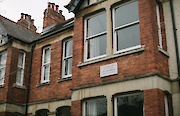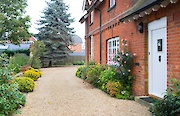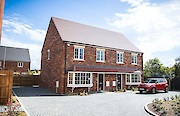


Head of Content

Mortgage Advisor & Director

Japanese knotweed is an invasive and fast-growing weed with robust roots that can cause structural issues to properties in the immediate vicinity.
Mortgage providers have always been cautious about lending on homes if the problematic plant is discovered growing on site or close by, but is it possible to get a mortgage on a property with Japanese knotweed? Let’s find out…
Can you get a mortgage on a property that has Japanese knotweed?
Yes. It is possible to get a mortgage on a property that has Japanese knotweed growing on its land. Although this has proven difficult for borrowers in the past, and some lenders will still be reluctant to approve you, recently-issued guidelines offer a potential lifeline.
In 2022, the Royal Institute of Chartered Surveyors (RICS) published new guidance on Japanese knotweed which concluded that the plant is less likely to cause significant structural damage than tree roots or woody plant species such as buddleia.
Although the weed is known to cause some issues to lightweight structures, freestanding walls, retaining walls, paths, drains and other ancillary features if left to grow unchecked, the general consensus is that mortgage lenders have been overcautious in the past.
As a result, some lenders have since relaxed their criteria towards Japanese knotweed and will approve applications where it is present on a case-by-case basis.
Lending criteria for homes with Japanese knotweed
RICS originally published a set of guidelines for determining how serious a Japanese knotweed infestation is, placing the issue in risk categories labelled 1 to 4.
The professional body has since issued new guidance on how lenders should view the weed, dividing the severity of infestations into management categories of A-D. Most mortgage lenders have updated their policies with these categories in mind.
The four management categories for assessing the severity of the issue are:
- Category A: This is when the Japanese knotweed is causing visible damage to the building’s structure. Mortgage providers are unlikely to lend unless remediation work is carried out by a Japanese knotweed removal specialist, covered by insurance.
- Category B: When Japanese knotweed is discovered on the premises but is only restricting access to amenity spaces rather than posing a risk of structural damage to the property. Most lenders will expect remediation work to be carried out.
- Category C: When the weed is present on the property but not causing any structural damage. Some mortgage providers might lend without any remedial work being carried out to remove the plant or contain its spread.
- Category D: Japanese knotweed is found within three metres of the property’s boundary, but not on the premises. This is the least severe of the categories.
If Japanese knotweed is suspected to be present at a property you are buying or remortgaging, a professional survey will need to be carried out by a PCA (Property Care Association) approved company to assess which category it falls in.
Your choice of mortgage lenders will be wider if the weed falls into category C or D, but keep in mind that you can be approved in the other categories if you provide proof that you have signed up for a treatment plan or to have the knotweed removed.
Other requirements
The management category your Japanese knotweed infestation falls into will play a major role in determining your mortgage eligibility, but you will also need to meet your mortgage provider’s general lending requirements, which are outlined below:
- Deposit requirements: Start at 5-10% of the property’s value, but depending on the management category the knotweed falls into, you may need to put down more.
- Credit history: Having clean credit history can help keep the level of risk to a minimum, but various bad credit mortgages are available.
- Age: Your mortgage options start to decrease if the mortgage term will run past your 75th birthday, especially if the property has Japanese knotweed too.
- Property type: The risk will increase if the property you are buying is classed as ‘non-standard’, which usually means it was built with materials other than your typical bricks and mortar. A specialist lender may be needed for this property type.
How to get a mortgage on a property with Japanese knotweed
If you are purchasing or remortgaging a property that has suspected Japanese knotweed on site or close by, the first step should be to have a survey carried out by a PCA (Property Care Association) approved company to assess which category it falls in.
When buying a house, the onus is on the seller to order the survey. They will provide a TA6 form once your offer has been accepted, and this will confirm if the weed is present.
At this point, it is a good idea to speak to a mortgage broker who specialises in properties with Japanese knotweed, as they can advise you on the next steps to take. Depending on which management category the issue falls into, you can either press ahead and apply for your mortgage, or wait until remediation work or removal has been booked in.
There are brokers on our team who have vast experience with Japanese knotweed, and they can guide you through the following steps to full mortgage application:
- Reviewing the survey results to assess the issue
- Advise you on whether remediation/removal work is necessary
- Advise you on the available lenders for your management category
- Help you choose the right lender and the best deal
- Oversee your mortgage application from start to finish
You can begin a free, no-obligation chat with a mortgage broker who specialises in Japanese knotweed to find out what your options are below:

Get expert advice about Japanese knotweed & mortgages
Which lenders offer mortgages for properties with Japanese knotweed?
Below you will find examples of lenders who will offer mortgages on properties where Japanese knotweed is present and the criteria they use to assess the issue:
- TSB: Will consider lending subject to a report outlining the issues and a quote from a treatment company who offer a warranty-backed treatment regime.
- Pepper Money: Will only lend if the Japanese knotweed is located outside of the property, more than seven metres away.
- Aldermore: Will lend if the Japanese knotweed is located on the property, but is more than seven metres from any habitable spaces.
- Swansea Building Society: Will lend provided there is an insurance-backed plan in place to eradicate the Japanese knotweed.
- Bluestone Mortgages: Will not lend if the Japanese knotweed falls into category A or B, but C and D are considered on a case-by-case basis.
Speak to a mortgage broker for a full list of available lenders and their criteria.
Buy-to-let mortgages for properties with Japanese knotweed

There are more than 50 mortgage lenders who are willing to consider applicants who are buying a property with Japanese knotweed for residential use (i.e. to live in), but for buy-to-let mortgages, the number is somewhat fewer, coming in at around 45.
Buy-to-let mortgage lenders use the same criteria to assess the risk posed by the weed infestation, with most making a decision based on the RICS management categories.
Your chances of mortgage approval will improve if the following applies:
- You have remediation/removal work carried out (if necessary)
- You can put down extra deposit
- You have landlord experience
- You apply through a mortgage broker
We have brokers on our team who specialise in buy-to-let mortgages - get in touch to set up a free, no-obligation consultation with one of them today.
Why choose Teito for your mortgage needs?
We have mortgage brokers available with a wealth of experience helping people secure finance for properties with Japanese knotweed, and they have the knowledge and lender connections to find the best solution to your plant-related problems.
Here are just some of the reasons why people choose Teito for their mortgage needs:
- Our brokers are experts on Japanese knotweed-affected properties
- They can help you access lenders who specialise in this issue
- We are 5-star rated on leading review websites
- You can secure an agreement in principle on Teito in minutes
Ready to book in a free, no-obligation chat with a broker who specialises in arranging mortgages for properties with Japanese knotweed - get started here.
FAQs
The answer depends on the size of the site that has been affected by the Japanese knotweed, with most removal specialists charging per square metre. To give an average cost, the removal of 5 square metres of the invasive weed can potentially cost between £1,500 and £2,500, while 20 square metres can cost upwards of £8,000.
Removal work should be carried out by a firm that is a member of the PCA (Property Care Association) or INNSA (Invasive Non-Native Specialists Association).
Choosing an Adviser
Selecting a qualified and experienced mortgage adviser is of great importance. To choose a suitable adviser, evaluate their qualifications, experience, and reputation, and ensure they are regulated by the Financial Conduct Authority (FCA).
Read reviews from previous clients and make sure they provide a clear explanation of the products and services they offer, as well as the fees and charges associated with them.

























































































































































